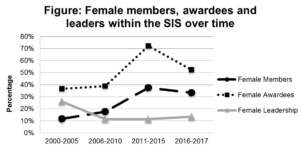Is There Gender Disparity Within the Surgical Infection Society?
Author(s):
Karla Bernardi; Nicole Lyons; Lillian Huang; Deepa Cherla; Julie Holihan; Alexander Martin; Alexis Milton; Tien Ko; Mike Liang; Lynn Hydo
Background:
Women are under-represented in academic surgery and surgical societies despite an increase in the percentage of female surgeons (24.0%) and surgery residents (34.6%). Publications, awards and society leadership positions are used for hiring and promoting surgeons.
Hypothesis:
We hypothesized that within the Surgical Infection Society (SIS) females are under-represented.
Methods:
The SIS website and databases were evaluated for the number of female members, awardees, and those in leadership positions. The data was divided in four different time periods: 2000-2005, 2006-2010, 2011-2015 and 2016-2017 and compared for changes over time utilizing Χ2. In addition, council members for five other surgical societies (AAST, ACS, EAST, Shock, Southern) were reviewed and the percentage of female representation in leadership positions compared.
Results:
Only 135/587 (23.0%) SIS members are female. There has been an increase in female membership over time (p<0.001; Figure). The number of female awardees has risen from 36.5% to over 50% in the last two study periods (p=0.002). Female representation in leadership positions decreased from 26.1% in 2000-2005 to less than 15% in the last three study periods (p=0.234; Figure).

When comparing the SIS with other surgical societies, similar disparities were seen (Table). Although some societies have better representation, most continue to have a disproportionately low number of females in leadership positions.
Conclusions:
Female surgeons are under-represented in SIS membership and leadership positions. While the number of female surgeon and resident participation has increased, these trends have not occurred with council membership in the SIS. There is a lack of female representation in leadership positions. This may be related to differences in pathway for membership as opposed to leadership. Membership is largely unrestricted while leadership positions require nominations by past members of the council. There is a need to address this gender disparity.

